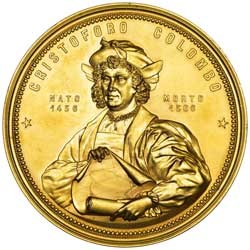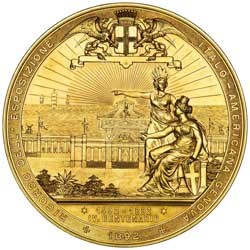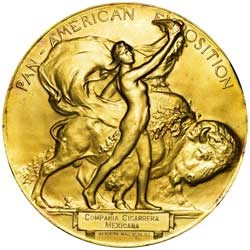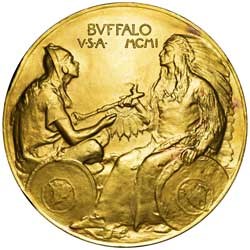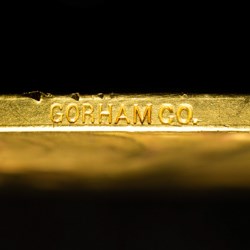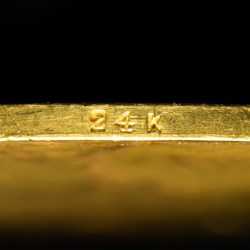Tokens & Medals — 2018 Highlights
Posted on 1/22/2019
2018 was another outstanding year for NGC certified oversize medals. With such a large canvas to work with, engravers have the opportunity to incorporate a much higher level of detail with more design elements, bigger landscapes and more complete busts. The state-of-the-art NGC Oversize Holder can accommodate most medals up to 120 mm in diameter, and up to 25 mm in thickness. For coins and medals larger than this, the NGC Mega holder can fit pieces as large as 180 mm in diameter.
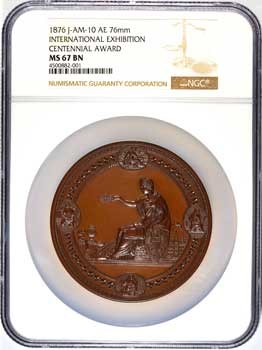 |
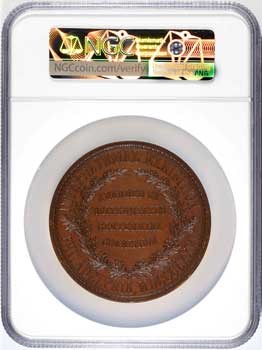 |
| J-AM-10: A three-inch bronze medal from the 1876 Centennial Exposition in Philadelphia. Click images to enlarge |
|
Medals did not circulate as a substitute for coinage like many tokens did. Therefore, they often exhibit little — if any — wear, and are generally graded based on the amount of cuts, hairlines, blemishes and other imperfections. However, medals larger than 50 mm take on other risks. Extreme care must be taken with oversize pieces, as they are easily damaged when dropped, and many of these medals exhibit rim dents or damage that will forever impair their appearance and value. Certain items like Peace Medals awarded to Indian Chiefs were intended to be worn, and thus often exhibit much wear, as well as dings, tooling, damage and/or cleaning. This doesn’t impact their value near as much as most medals though. For medals that were issued holed, NGC does not penalize them with a “holed” Details grade.
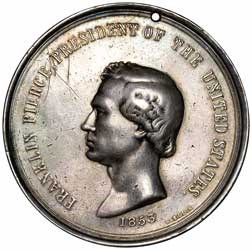 |
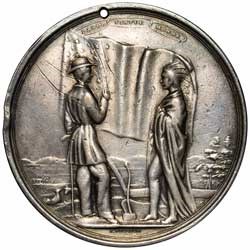 |
| J-IP-33: Here is a rare Franklin Pierce Indian Peace medal exhibiting tooling. Click images to enlarge |
|
According to R.W. Julian, “Medals [struck at the US Mint] were almost always struck on a screw press prior to 1894.” This was because one blow from a coining press could not come close to bringing out the full relief of the design. Their sheer size combined with a very high relief requires much more pressure and many more strikes. This is why it would take the Mint months to complete even a small order of 3-inch medals that might take 15-25 strikes to complete the relief and a total 30 hours to make just one medal. Julian notes that larger four-inch medals, like the Joseph Francis, medal took as many as 50 blows, with annealing between each one to flesh out the design. A new hydraulic press received at the Mint in 1894 took just two or three strikes and a new medal could be produced in one hour.
For the list below, large format medals were chosen that are especially rare, aesthetically pleasing, or have an interesting historical context. This short list does not necessarily include the most expensive items submitted, and there were many more interesting pieces that are not included. Enjoy the following five oversize medals that are plush with craftsmanship, history, and beauty.
5. 1892 Italian-American Exposition Medal, Eglit-582
One of the most beautiful medals associated with the Columbian Exposition that NGC graded was this giant 3.5-inch medal honoring Columbus. The medal was issued to commemorate the Italian-American Exposition that was held in Genoa, Italy in 1892, which celebrated the 400th anniversary of the discovery of America. This exposition ran from July 10 to December 4 and drew 808,572 visitors, versus the much larger Columbian Expo in Chicago, which ran from May 1, 1893 to October 30, 1893, and drew over 27 million visitors.
This is a larger version of Eglit-427, and is similar to Eglit-273. The American version from the Columbian Expo in Chicago is Eglit-55, and was made by the same firm. The obverse features a half-length bust of Columbus wearing a soft cap, holding a chart. The reverse has two female figures — an Indian Princess pointing out to a seated Italia three caravels sailing towards a setting sun (Columbus’ three ships that began the voyage). Exposition buildings are behind them, and the arms of Genoa above. Eglit notes that this medal “is one of the finest examples of the works of Wilhelm Mayer.” Mayer’s initials appear on the smaller version. The medal above is gilt-bronze and graded NGC MS 64. It also exists in bronze, aluminum, and presumably silver.
4. Military Service Institution Award Medal to General John Gibbon
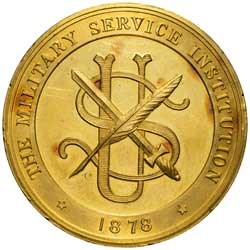 |
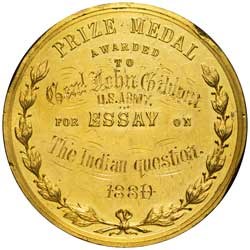 |
| General John Gibbon's gold Prize Medal was awarded for his essay "The Indian Question." The last digit was changed from a "0" to a "1." Click images to enlarge |
|
There are few medals that can compare to the rich historical significance of this medal awarded to General John Gibbon by the Military Service Institution for his essay, “The Indian Question”. Gibbon played significant roles in both the American Civil War and the ensuing Indian wars. He served in the US Army for over four decades, and his division bore the brunt of Pickett’s famous charge at Gettysburg, in which he was wounded. He was also wounded at the Battle of Fredericksburg. Despite his participation in the Indian wars, Gibbon was sympathetic toward the Native Americans. He once testified before a Congressional panel:
There is no question in my mind that the Indians on this continent are the worst-abused people on the face of the globe. Under our present system they are cheated, defrauded and encroached upon in such a way that, sooner or later (and it is only a question of time), every peaceful tribe upon this continent will turn hostile; and I would have no opinion of their manhood if they did not turn hostile.
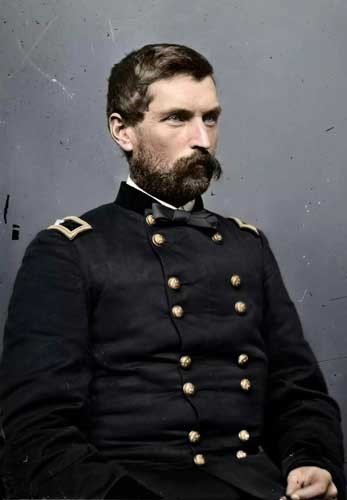 |
|
| A color-enhanced photo of General John Gibbon in his Civil War attire. Click images to enlarge |
|
The medal, certified by NGC, brought $2,160 last month at Heritage.
3. 1908 Catholic Diocese of New York Gold Medal
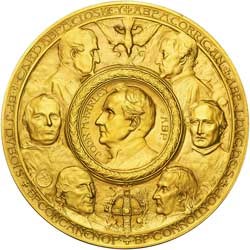 |
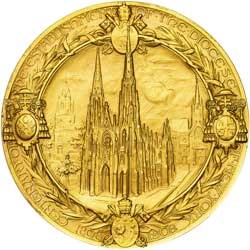 |
| This 76 mm gold medal was struck for Pope Pius X, but was supposedly never delivered to him. Because it saw such minimal handling, it graded NGC MS 68. Click images to enlarge |
|
This medal celebrated the centennial of the Catholic Diocese of New York in 1908. The obverse features Archbishop John Farley, surrounded by portraits of his six predecessors. A dove representing the Holy Trinity is above, and below is a pectoral cross. The reverse features St. Patrick’s Cathedral, with St. Peter’s Church of 1808 and St. Patrick’s Church of Mott Street (1815) in the background.
According to the reference Medallic Art of the American Numismatic Society, 1865-2014, only a single gold specimen was struck and presented to Pope Pius X. That medal supposedly bore the serial number 1. It also mentions that a gold medal had formerly been in the possession of Anthony Terranova, “who was informed that it was the one given to Pope Pius X but apparently never forwarded to him.” Supposedly, the medal was in the New York church’s inventory for a long time, until it was sold privately after a "house cleaning." The medal was then sent to NGC by another party. With the medal’s provenance, and the fact that Bauman L. Belden’s original ANS catalog never mentions the gold medal is marked, corroborates this story.
A vintage publication of a weekly Catholic journal, America a Catholic Review of the Week, had this to say under its section for February 19, 1910:
The vice-rector of the American College, Rev. Father O’Hern, when he sailed for Rome last Saturday, took with him by request of Archbishop Farley, for Pope Pius X, the first medal struck to commemorate the centenary of the founding of the Diocese of New York. The medal is of American gold, three inches in diameter, and weighs eight ounces.
The journal also describes, in great detail, the case the medal was sent in, and also mentions that a silver medal was sent to Cardinal Merry del Val, papal Secretary of State, and a bronze example was provided to the American College in Rome. Therefore, despite the medal being taken to Rome, it must have been returned to St. Patrick's Church, from which the medal emerged. Why the pope didn't receive his medal, we may never know.
2. 1901 Pan-American Exposition Gold Medal
One of the most expensive medals submitted was this 64 mm 1901 Pan-American Exposition award medal in solid gold. On the edge is stamped “24k” and the medal is awarded to “Compania Cigarrera Mexicana.” The medal is one of possibly just two known. The other medal was also certified by NGC, but is bent and scratched. Despite this, it sold for nearly $47,000 in February of 2017. The above medal was graded NGC MS 63 and is currently for sale for $68,500 at the time of publishing. To read more about these beautiful medals as well as the 1901 Pan-American Exposition and the dramatic history that took place there, check out our article here.
1. (c.1873) George F. Robinson Silver US Mint Medal
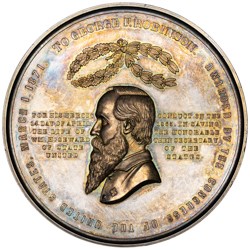 |
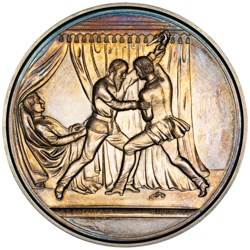 |
| J-PE-33: A medal honoring George F. Robinson for his heroics on the night of Abraham Lincoln's assassination.
Click images to enlarge |
|
The heroics of George F. Robinson on the night of April 14, 1865 are hidden in the dark shadow of President Lincoln’s assassination. Just a few blocks from the theater where Lincoln was shot, another would-be assassin affiliated with John Wilkes Booth was trying to kill Secretary of State William H. Seward. Two more assassinations were planned for Vice President Johnson and General Ulysses S. Grant, but were never carried out.
Robinson was a 32-year-old Union sergeant who was recovering from battlefield wounds, but was assigned to Seward as an attendant. The Secretary was bedridden from a carriage accident that had occurred 10 days prior.
Seward's assailant, Lewis Payne, had a pistol that he tried to fire at a man standing in the hallway outside. When it misfired, he knocked the man unconscious, and burst into Seward’s bed chamber brandishing a Bowie knife. Robinson leapt into action, but was eventually knocked to the ground with a blow to the head by the handle of Payne’s knife. Stunned, and bleeding, Robinson recovered to reengage Payne, who began stabbing the secretary. During a second struggle, Robinson was cut in the back, but Payne fled the room. He was captured three days later, and subsequently hanged.
With the hand of providence, Seward, Robinson and three others who were injured that night, survived. In addition to a reward of $5,000 cash, Congress awarded him with a custom gold medal, which was engraved by Anthony C. Paquet, and struck in 1873. Robinson’s gold medal was sent to the Smithsonian in 1947.
The medal was also struck in silver and bronze, but is extremely rare. It is believed that fewer than 100 were struck in bronze, and just two, including the one above, were struck in silver. This medal has a pedigree going back to 1884, and was graded NGC MS 63. It brought $14,400 in a Stack’s Bowers sale in August 2018 at the ANA World's Fair of Money.
Stay Informed
Want news like this delivered to your inbox once a month? Subscribe to the free NGC eNewsletter today!
